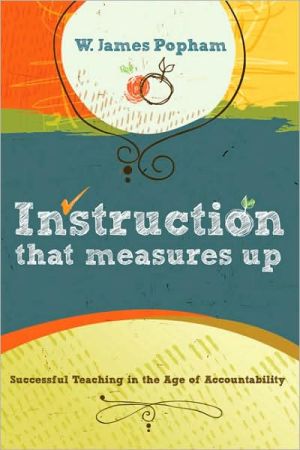

 |

|

The average rating for Instruction That Measures Up: Successful Teaching in the Age of Accountability based on 2 reviews is 4.5 stars.
Review # 1 was written on 2012-07-18 00:00:00 Jan Smith Jan SmithI was in the bookstore on Saturday, saw that Charles Murray had put out a new book, and said, "Dammit," because I knew I HAD to read it and therefore shell out $25 for it. He discusses four truths of contemporary American education. I think his first two truths (ability varies; half of all children are below average) are undebatable. Few would disagree with his fourth truth (America's future depends on the education of the academically gifted) on its face, but they might disagree with his recommendations for their education. The third truth (too many kids go to college) is likely the most controversial, but also the one most worth reading. Murray argues convincingly that we're too obsessed with sending college-aged kids to college, which is different from educating college-aged kids. Never mind that a lot of kids aren't well-suited for college, but college doesn't provide what would be best for a lot of kids. Anyhoo. Worth reading. The sad thing is that too many people will think, "Charles Murray? Isn't he that Bell Curve guy?" and dismiss the book entirely. Parents, teachers, administrators, school board members, education bureaucrats, and politicians at each level of government would do well to read this book and internalize its message. |
Review # 2 was written on 2010-04-27 00:00:00 Roy Barquet Roy BarquetCharles Murray is one of the best known researchers and writers on various public policy topics. He is oftentimes maligned due to the fact that many of his positions and arguments fly in the face of the popular wisdom and challenge some of our most cherished prejudices. In the case of education, those prejudices have been the source of countless "reforms" that have had very little, if any, impact on the actual achievements of students they were meant to help. The latest one of those attempts, the No Child Left Behind act (NCLB) was the immediate inspiration of a series of articles that Charles Murray wrote for the Wall Street Journal. Those articles have been expanded and turned into this book. Because of politically sensitive nature of the topic, Murray is banding backwards to try to make his assumption as uncontroversial as possible and avoid for the most part the minefields of race, class and gender. The four assumptions that he bases all of his arguments are the following: 1. Ability varies. 2. Half of the children are below average. 3. Too many people are going to college. 4. America's future depends on how we educate the academically gifted. The veracity of some of these assumptions can hardly be questioned - the second one is just a tautology. However, most people don't look education or their intellectual ability rationally, so it is worthwhile emphasizing the obvious. On the other hand the last two assumptions are very politically unpopular, and Murray expends considerable amount of space in backing them up and presenting the best possible arguments in their favor. Unfortunately, I am not too optimistic that this book will have much of an impact on people who really need to make hard political choices. The real hope for change lays elsewhere - in an increasing number of technological and social developments that will create new pressures on the traditional educational system. The advent of the internet and the growing amount of resources for learning outside of the established educational venues will create an incentive for more flexible and diverse educational experience. The globalization of work will create pressures on schools and colleges to become more open to changes that will bring them in line with reality. In a meanwhile, we have to be grateful that there are people out there like Charles Murray who are willing to write so clearly and persuasively about these issues. This is also probably Charles Murray's most accessible book so far. It is written in a conversational/polemic style with no footnotes, graphs, or tables. It is a very straightforward read and could be finished in a single sitting. Overall, there is so much going for this book that I really hope it will be read by a very wide audience. |
CAN'T FIND WHAT YOU'RE LOOKING FOR? CLICK HERE!!!